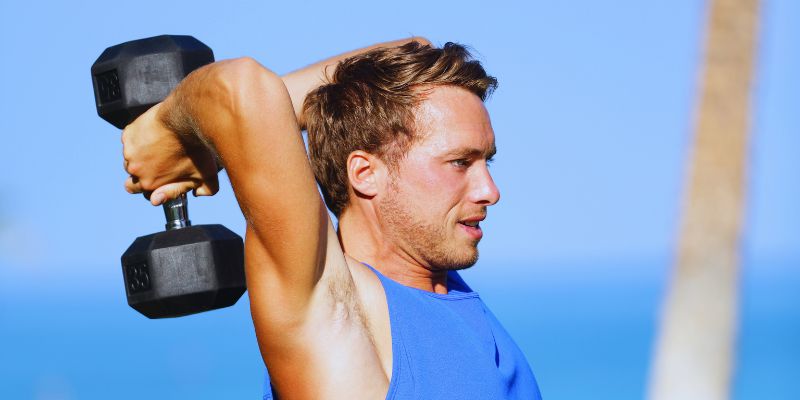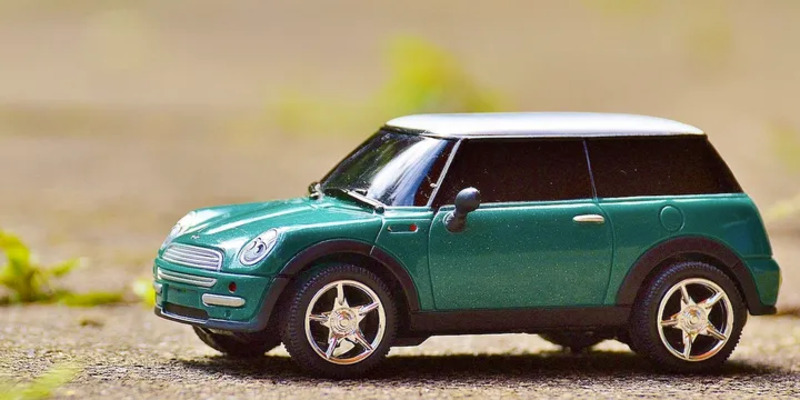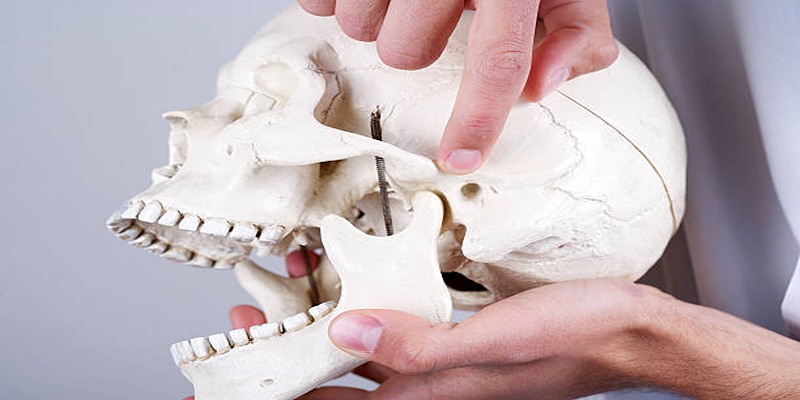How to Do Proper Overhead Tricep Extensions: An Ultimate Guide For Beginners
One excellent exercise for developing the back of the upper arms is the overhead tricep extension. It increases general strength, defines arms better, and builds muscle. For many novices who struggle with proper form, which can cause strain or damage, targeting the triceps brachii—essential for arm motions—is an exercise that helps. Preventing problems requires knowing the right approach.
Resistance bands, barbells, or dumbbells will all work for this exercise. Anyone can include this basic but powerful movement in their exercise program. This guide will enable you to perform overhead tricep extensions correctly, whether working out at home or the gym. Use meticulous procedures to prevent errors. Review the advantages, proper form, variants, and typical mistakes. You will be more confident in doing this task correctly.
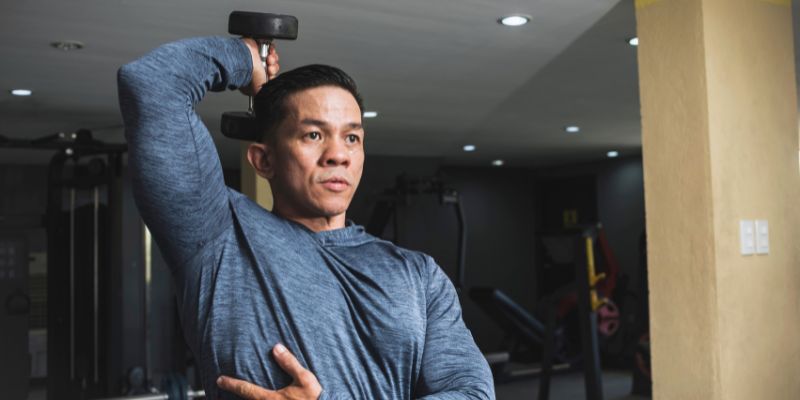
Benefits of Overhead Tricep Extensions
The overhead tricep extension tones and strengthens the triceps, enhancing arm definition. It also improves shoulder stability and flexibility, so supporting general upper-body power. Below are some of the best benefits of overhead tricep extensions.
- Strengthens the Triceps: This exercise directly targets the triceps, helping to increase strength and build muscle. In pushing motions like bench presses and push-ups, strong triceps help to enable improved performance.
- Enhances Arm Definition: Frequent performance of this exercise tones the arms, therefore enhancing their definition. Those trying to get a sculpted look and cut flabbiness will find this fantastic.
- Improves Shoulder Stability: Maintaining the arms overhead throughout this exercise stabilizes the shoulders. Strong shoulders lower injury risk and help to correct posture.
- Increases Range of Motion: Deep triceps stretching made possible by overhead tricep extensions increases triceps flexibility and mobility. It facilitates other exercises and daily tasks.
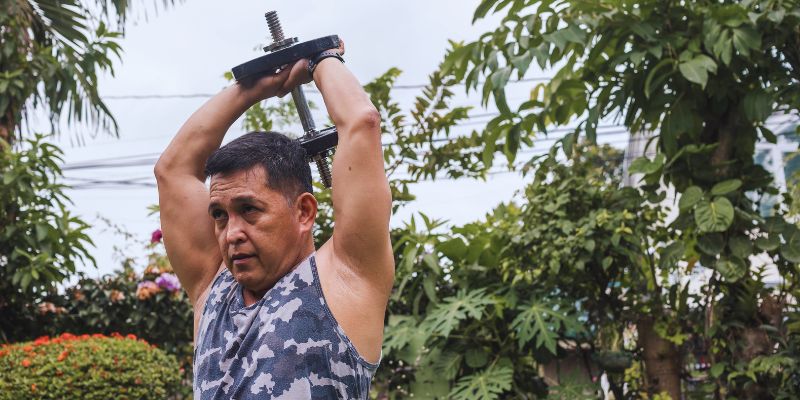
How to Do Overhead Tricep Extensions Correctly?
To adequately engage the triceps, keep your elbows close back straight and stretch your arms.
- Step 1: Choose the Right Equipment: For beginners, start with a light dumbbell; else, use a barbell or resistance band. Choose a weight that would enable the correct form to be tension-free.
- Step 2: Get Into Position: With feet shoulder-width apart, stand holding the dumbbell above your head. Keep elbows tight to your ears; try not to let them flare out throughout the motion.
- Step 3: Lower the Weight: Keep control, slow down your elbow bending, and reduce the weight behind your head. Stop to guarantee constant movement when forearms parallel the floor.
- Step 4: Extend Your Arms: Reversing the weight, completely extend your arms, but avoid locking your elbows. Go steadily and work your triceps all through.
- Step 5: Repeat the Movement: Aim for 3-4 sets, depending on your degree of fitness; perform 10–15 reps every set. Rest for 30 to 60 seconds between sets to recuperate.
Common Mistakes to Avoid
Avoid these common mistakes below to do the overhead tricep extension and gain more benefits correctly.
- Using Too Much Weight: Many times, beginners use overly heavy weights, which results in incorrect form and possible injury. Start with less weight to guarantee correct technique; then, as strength increases, progressively raise it.
- Flaring the Elbows: Your elbows should remain near your head throughout the workout. Flaring them outward could strain your shoulders and lessen the exercise's efficiency. Keep your elbows straight and near your ears.
- Arching the Back: Maintain a neutral spine. Overusing arching the back might strain the lower back. Keep your back straight, work your core, and avoid too-curvaceous protection.
- Not Extending Fully: To correctly engage the triceps, extend your arms at the movement's height. Incomplete extension reduces muscle activation, limiting the exercise's efficacy. Steer clear of locking elbows as you work through the entire range of motion.
Variations of Overhead Tricep Extensions
Target your triceps unusually and boost muscle development by trying several variations.
- Seated Overhead Tricep Extensions: Sit on a bench with back support to keep the correct posture. This variation lowers the danger of injury by better stabilizing the triceps and avoiding needless movement, enabling concentration on them.
- Single-Arm Tricep Extension: Work one arm at a time to balance muscles. This version also increases coordination, so you may isolate each tricep for more focused strengthening and control.
- Cable Overhead Tricep Extensions: Perform the workout standing using a rope hooked to a cable machine. This version provides continuous tension throughout the action, producing a more uniform workout for maximum tricep activation.
- Barbell Overhead Tricep Extensions: The overhead tricep extension pushes both arms at once using a barbell. For advanced trainees trying to boost their load, this variation can help them build balanced strength.
Safety Tips and Precautions
Below are some safety tips and precautions for doing overhead tricep extensions.
- Warm-Up Before Starting: Reducing the risk of injury requires warm-up. Do mild stretches and arm circles to release your muscles and prepare your body for the overhead tricep extensions exercise.
- Maintain a Strong Core: Use your core throughout the workout to help your lower back. Strong core guarantees you can complete the movement safely and successfully, helps maintain good posture, and reduces strain.
- Use a Spotter for Heavy Weights: Always have a spotter at hand for safety while lifting heavy weights. A spotter may help you keep correct form, assist with lifting, and make sure you don't risk damage pushing yourself.
- Stop if You Feel Pain: Although minor discomfort is typical of exercise, acute or unusual pain is a warning indicator. If you feel pain, stop immediately; continuing could cause damage over time.
Conclusion:
The outstanding overhead tricep extension can develop stronger and more defined arms. It works the triceps, enhancing shoulder stability, muscle strength, and flexibility. To prevent damage, beginners should preserve correct form, execute controlled motions, and progressively add weight. Common errors such as flaring elbows, running through the exercise, or using too much weight can lower performance and raise injury risk. Changing your routine with sitting, single-arm, or cable extensions can provide challenge and thrill. Always remember that before your exercise, warm up; then stretch to help muscles recover and flexibility.





